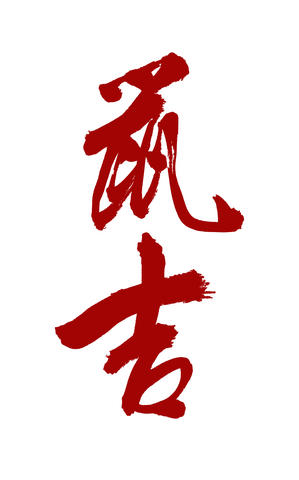Putting pigs behind us, today marks the beginning of the Year of the Rat, the first animal in the Chinese zodiac.
Dirty little vermin you might say, with no place in the exulted pantheon of heavenly symbols that make up the Chinese zodiac. But the rat's cunning is legendary: It got into the zodiac by winning a race using brainpower rather than physical power. As with most myths, there are many versions of the story that follows, but the general idea is this.
Back in deepest antiquity, the story goes, the Jade Emperor, ruler of heaven, decided to organize a race for all the animals of the earth. The stakes: The first 12 to finish would be included in the cycle of zodiac animals by which the heavens and time itself were organized. The cat and the rat, both lazy creatures, weren't sure they could get up in time for the big event. They asked the ox to wake them at dawn on the day of the race. The big day came along and the ox dutifully went to wake them. Try as it might, it couldn't. They just murmured, rolled over and went back to sleep.

ILLUSTRATION: JERRY HUANG
Unable to wake them, the ox coaxed the two lazy animals onto his back and set off to join the race. The cat and rat remained there when the race began.
Fast forward to the end of the race. The ox, with his enormous strength and determination, was ahead of the rest. The final hurdle was a river, and as the ox waded across, the rat finally woke. It realized it could never beat the cat in the final sprint to the finish, so grasping the chance fate offered, it pushed the still-sleeping cat into the river. When the ox got to the other side, the rat jumped off its back and scampered across the finish line just ahead of the ox. That's why in the Chinese zodiac the rat is always listed first and is followed by the ox. It is also why the cat is not in the Chinese zodiac and the enmity between cat and mouse continues to this day.
BRAIN VS brawn
The relationship between the rat and the ox, which helped the rat win the race, is one of the most highly regarded pairings within the zodiac. The rat represents intelligence, but without the diligence of the ox this easily degenerates into cunning. On the other hand, the ox with its enormous strength could have made it to the finish line first if it had been a little sharper. Put the qualities of the two together and you have an unbeatable combination. But how to make that combination come about depends on your stars.
Unfortunately, the undesirable characteristics of the rat have become more commonplace in everyday language, with the lexicon focusing more on their cunning than their intelligence. "The rat sees only an inch in front of its face" (鼠目寸光, shumuchunguang), is used to describe a person who cannot see beyond immediate personal gain. "Head of a water deer and face of a rat" (獐頭鼠面, zhangtoushumian) refers to someone thoroughly untrustworthy and "ruined by rat-like suspicion" (鼠首僨事, shushoufenshi) refers to a person full of hesitation and suspicion who undermines a joint project.
It's not a good record, and a person born in the year of the rat might well feel that he or she is like "a rat crossing the road" (老鼠過街, laoshuguojie) - a target of common abuse (人人喊打, renrenhanda).
Even when we look to the fortune-tellers, it is clear that despite the rat coming first in the list of zodiac symbols, it is a birth sign loaded with bad character traits. The rat is lazy (it needed the ox to take it to the races), an opportunist and a gossip. Looking on the brighter side, the rat is sociable, imaginative and adaptable. They are also sensitive to their environment, and it is well known that rats are the first to leave a sinking ship. It is a quality they can turn to their advantage. In general, people born in the Year of the Rat are suited to be artists, inventors, revolutionaries and politicians. It might be worth taking a tally of the number of rats in government.
So another cycle of the Chinese zodiac begins. It's worth noting that while the rat managed to win the race despite its laziness, the pig, which came in 12th, was last because it stopped mid-race to eat and take a nap.
But however you to get through the finish line in the Year of the Rat, we at the Taipei Times wish you a very happy New Year and the best of fortune.

Seven hundred job applications. One interview. Marco Mascaro arrived in Taiwan last year with a PhD in engineering physics and years of experience at a European research center. He thought his Gold Card would guarantee him a foothold in Taiwan’s job market. “It’s marketed as if Taiwan really needs you,” the 33-year-old Italian says. “The reality is that companies here don’t really need us.” The Employment Gold Card was designed to fix Taiwan’s labor shortage by offering foreign professionals a combined resident visa and open work permit valid for three years. But for many, like Mascaro, the welcome mat ends at the door. A

Last week gave us the droll little comedy of People’s Republic of China’s (PRC) consul general in Osaka posting a threat on X in response to Japanese Prime Minister Sanae Takaichi saying to the Diet that a Chinese attack on Taiwan may be an “existential threat” to Japan. That would allow Japanese Self Defence Forces to respond militarily. The PRC representative then said that if a “filthy neck sticks itself in uninvited, we will cut it off without a moment’s hesitation. Are you prepared for that?” This was widely, and probably deliberately, construed as a threat to behead Takaichi, though it

If China attacks, will Taiwanese be willing to fight? Analysts of certain types obsess over questions like this, especially military analysts and those with an ax to grind as to whether Taiwan is worth defending, or should be cut loose to appease Beijing. Fellow columnist Michael Turton in “Notes from Central Taiwan: Willing to fight for the homeland” (Nov. 6, page 12) provides a superb analysis of this topic, how it is used and manipulated to political ends and what the underlying data shows. The problem is that most analysis is centered around polling data, which as Turton observes, “many of these

Since Cheng Li-wun (鄭麗文) was elected Chinese Nationalist Party (KMT) chair on Oct. 18, she has become a polarizing figure. Her supporters see her as a firebrand critic of the ruling Democratic Progressive Party (DPP), while others, including some in her own party, have charged that she is Chinese President Xi Jinping’s (習近平) preferred candidate and that her election was possibly supported by the Chinese Communist Party’s (CPP) unit for political warfare and international influence, the “united front.” Indeed, Xi quickly congratulated Cheng upon her election. The 55-year-old former lawmaker and ex-talk show host, who was sworn in on Nov.